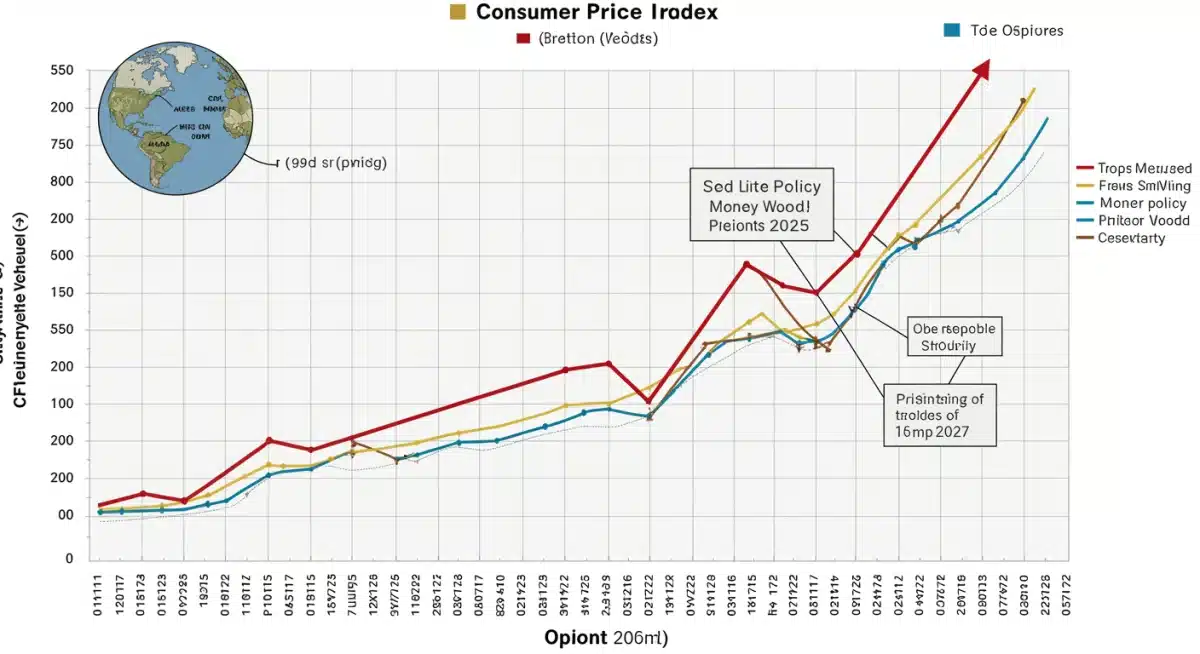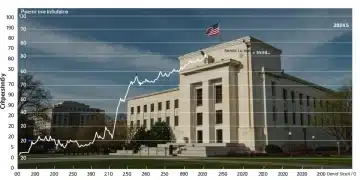Gold Standard to Fiat: US Monetary Policy & 2025 Inflation

The journey from the gold standard to fiat currency fundamentally reshaped US monetary policy, a shift now under scrutiny for its potential inflationary implications as 2025 approaches, impacting global financial stability.
Recent economic analyses are bringing into sharp focus the historical trajectory of US monetary policy, specifically the profound shift from a gold-backed system to a fiat currency regime, and how this evolution could echo into potential inflationary pressures by 2025. Understanding this historical context is crucial for anticipating future economic trends.
The Gold Standard Era: Stability and Constraints
The United States operated under various forms of the gold standard for over a century, a system that anchored the value of the dollar directly to a fixed quantity of gold. This era, characterized by relative price stability, also imposed significant constraints on monetary policy, limiting the government’s flexibility in responding to economic crises.
From its inception, the gold standard provided a credible commitment to stable money, fostering international trade and investment by reducing exchange rate volatility. However, this stability came at a cost, as the supply of money was inherently tied to the availability of gold, often hindering economic expansion or recovery during downturns.
Key Characteristics of the Gold Standard
- Fixed Exchange Rates: Currencies were convertible into a predetermined amount of gold, stabilizing international trade.
- Limited Monetary Supply: The amount of currency in circulation was constrained by the nation’s gold reserves.
- Price Stability: Long-term inflation was generally low due to the intrinsic value of gold.
- Economic Constraints: Governments could not easily print money to stimulate the economy or finance large deficits.
The system, while offering a semblance of financial discipline, often led to deflationary spirals during economic contractions, as central banks were unable to expand the money supply effectively. This inherent rigidity became a significant challenge during periods of crisis, ultimately paving the way for a more adaptable monetary framework.
The Great Depression and the Shift Away from Gold
The economic devastation of the Great Depression exposed the fundamental weaknesses of the gold standard, forcing a dramatic reevaluation of US monetary policy. Faced with widespread bank failures, mass unemployment, and a plummeting economy, the rigid constraints of gold convertibility proved untenable for effective crisis management.
In 1933, President Franklin D. Roosevelt took decisive action, severing the dollar’s direct link to gold for domestic purposes and devaluing the currency against gold. This move allowed the Federal Reserve greater latitude to increase the money supply, providing much-needed liquidity to the banking system and stimulating economic activity. The emergency measures, initially controversial, marked a pivotal moment, demonstrating the government’s willingness to prioritize economic recovery over strict adherence to gold-backed currency principles.
Roosevelt’s Monetary Reforms
- Executive Order 6102: Required citizens to deliver all gold coins, bullion, and certificates to the Federal Reserve.
- Gold Reserve Act of 1934: Officially changed the statutory price of gold from $20.67 to $35 per troy ounce.
- Increased Monetary Flexibility: Allowed the Federal Reserve to expand the money supply to combat deflation.
These actions, though partial and not a complete abandonment of gold, provided critical flexibility. They set a precedent for future monetary interventions, highlighting that in times of severe economic distress, the stability offered by the gold standard could be outweighed by the need for active monetary management to avert deeper crises.
Bretton Woods and the Gold-Exchange Standard
Following World War II, the international community convened at Bretton Woods, New Hampshire, in 1944 to establish a new global monetary order. This agreement created a gold-exchange standard, with the U.S. dollar at its center, convertible to gold at a fixed rate of $35 per ounce, and other currencies pegged to the dollar. The Bretton Woods system sought to combine the stability of gold with the flexibility of fiat currency, aiming to prevent the competitive devaluations and trade wars that plagued the interwar period.
The system fostered a period of unprecedented global economic growth and stability, largely due to the dollar’s strength and the U.S.’s dominant economic position. Member countries held their reserves primarily in U.S. dollars, which could theoretically be converted into gold at the Federal Reserve. This arrangement provided a stable framework for international trade and investment, facilitating post-war reconstruction and expansion.
However, the system contained inherent contradictions. As global trade expanded and the U.S. ran persistent balance of payments deficits to supply the world with dollars, the amount of dollars held by foreign central banks eventually exceeded the U.S. gold reserves. This imbalance led to a growing lack of confidence in the dollar’s convertibility, known as the Triffin Dilemma.
Challenges to Bretton Woods
- Triffin Dilemma: The conflict between domestic monetary policy and international liquidity needs.
- U.S. Balance of Payments Deficits: Necessary to provide global dollar liquidity but eroded confidence in gold convertibility.
- Speculative Attacks: Growing doubts about the dollar’s backing led to demands for gold conversion.
By the late 1960s and early 1970s, the pressures on the Bretton Woods system became unsustainable. Mounting inflation in the U.S., fueled partly by spending on the Vietnam War and social programs, further strained the dollar’s credibility, ultimately leading to its demise.
Nixon Shock and the Advent of Pure Fiat Currency
The year 1971 marked a watershed moment in the history of US monetary policy, forever altering the global financial landscape. Facing severe economic challenges, including persistent inflation and a dwindling gold supply, President Richard Nixon unilaterally suspended the convertibility of the U.S. dollar into gold for foreign central banks. This action, famously known as the “Nixon Shock,” effectively ended the Bretton Woods system and ushered in the era of pure fiat currency.
Nixon’s decision was a direct response to a growing crisis of confidence in the dollar. Foreign governments, notably France, were increasingly demanding gold in exchange for their dollar holdings, threatening to deplete the U.S. gold reserves. The move was designed to protect the dollar’s value and provide the U.S. with greater economic maneuverability, allowing the Federal Reserve to manage the economy without the constraints of gold backing. This shift meant that the dollar’s value would now be determined solely by market forces and the trust placed in the U.S. government and its central bank.
Immediate Impacts of the Nixon Shock
- Floating Exchange Rates: Currencies were no longer pegged to the dollar or gold, leading to market-determined exchange rates.
- Increased Monetary Autonomy: The Federal Reserve gained full control over the money supply, no longer constrained by gold reserves.
- Initial Market Volatility: Global financial markets experienced significant uncertainty and adjustments.
The end of the gold standard had profound long-term implications. While it granted central banks unprecedented power to influence economic conditions through monetary policy, it also introduced new challenges, particularly regarding inflation. Without the discipline of gold, the potential for governments to finance deficits through money creation became a more significant concern, setting the stage for future debates on price stability and central bank independence.
The Era of Central Bank Independence and Inflation Targeting
With the full transition to a fiat currency system, the role of the Federal Reserve fundamentally transformed. No longer constrained by gold reserves, the Fed gained immense power to influence economic activity through controlling the money supply and interest rates. This newfound autonomy led to a focus on central bank independence and explicit inflation targeting as primary policy objectives, particularly after the high inflation of the 1970s.
Central bank independence refers to the idea that monetary policy decisions should be made free from direct political interference, allowing central banks to pursue long-term economic stability without succumbing to short-term political pressures. This principle became widely accepted as a crucial element for maintaining price stability in a fiat money system. Inflation targeting, where central banks publicly commit to achieving a specific inflation rate, emerged as a key framework for guiding monetary policy decisions and anchoring public expectations.
Evolution of Monetary Policy Tools
- Interest Rate Adjustments: The primary tool for influencing borrowing costs and economic activity.
- Quantitative Easing/Tightening: Large-scale asset purchases or sales to inject or withdraw liquidity.
- Forward Guidance: Communicating future policy intentions to influence market expectations.
The Federal Reserve’s dual mandate—to achieve maximum employment and stable prices—became the guiding principle. While providing flexibility to respond to economic shocks, this era also highlighted the delicate balance central banks must strike. The absence of a physical anchor like gold necessitates strong institutional frameworks and clear communication to maintain credibility and manage inflation expectations effectively.
2025 Inflationary Echoes: Historical Parallels and Modern Risks
As 2025 approaches, analyses suggest that current economic conditions bear striking resemblances to past periods of inflationary pressure, drawing direct parallels to the historical shifts in US monetary policy. The expansion of the money supply, large government deficits, and supply chain disruptions observed recently echo dynamics seen during the transition away from the gold standard and the subsequent inflationary decades.

The ability of the Federal Reserve to expand its balance sheet and maintain low interest rates for extended periods, a power unimaginable under a gold-backed system, has fueled concerns about potential overheating and sustained price increases. With no intrinsic value anchoring the currency, the perception of its value and the public’s inflation expectations become paramount. If these expectations become unanchored, the risk of a self-fulfilling inflationary spiral significantly increases.
Factors Contributing to 2025 Inflation Concerns
- Persistent Fiscal Deficits: Government spending financed by debt, potentially monetized by the central bank.
- Global Supply Chain Issues: Continued disruptions limiting supply and pushing up prices.
- Wage-Price Spiral Risk: Rising wages leading to higher prices, which in turn demand higher wages.
- Geopolitical Instability: Conflicts and trade tensions impacting commodity prices and supply.
The modern fiat system, while offering flexibility, demands vigilant oversight. The historical record demonstrates that unchecked monetary expansion, even with the best intentions, can lead to significant inflationary consequences. Policymakers must now navigate a complex economic landscape, balancing the need for growth with the imperative of maintaining price stability, learning from the lessons of the past to mitigate future inflationary echoes.
| Key Policy Shift | Brief Description |
|---|---|
| Gold Standard Era | Dollar pegged to gold, ensuring stability but limiting monetary flexibility. |
| Nixon Shock (1971) | Ended gold convertibility, ushering in a pure fiat currency system. |
| Central Bank Independence | Federal Reserve gained autonomy, focusing on employment and price stability. |
| 2025 Inflation Outlook | Concerns over fiscal deficits and money supply expansion echoing past inflationary periods. |
Frequently Asked Questions About US Monetary Policy
The gold standard provided inherent price stability and a credible commitment to a fixed currency value. This reduced inflation risks and fostered international trade by minimizing exchange rate volatility, as the money supply was directly tied to a tangible asset.
The gold standard was abandoned primarily due to its rigidity during economic crises, notably the Great Depression, and later, the unsustainable pressure on US gold reserves under the Bretton Woods system. It limited the government’s ability to stimulate the economy.
A fiat currency system, unlike the gold standard, is not backed by a physical commodity. Its value is derived from government decree and public trust. This grants central banks greater flexibility in managing the money supply and interest rates to influence economic conditions.
Central bank independence aims to insulate monetary policy decisions from short-term political pressures. This allows central banks to prioritize long-term price stability and manage inflation expectations more effectively, which is crucial in a fiat currency system without a gold anchor.
Concerns stem from persistent government deficits, expansive monetary policies, and ongoing global supply chain disruptions. These factors, reminiscent of past inflationary periods, could lead to sustained price increases if not carefully managed by policymakers and the Federal Reserve.
Looking Ahead: Navigating Future Financial Landscapes
The historical transition of US monetary policy from the gold standard to a fully fiat-based currency system provides a powerful framework for understanding present economic tensions. As 2025 approaches, inflationary pressures and geopolitical financial shifts are reviving public debate on monetary discipline, currency credibility, and long-term price stability. These developments highlight the need for clear communication and decisive action from the Federal Reserve to sustain confidence in the fiat system while avoiding the pitfalls of unchecked liquidity expansion.
In an environment where market sentiment can shift rapidly, studying foundational monetary principles — including educational resources on the gold standard like https://www.stlouisfed.org/timely-topics/the-gold-standard/videos/part-1-what-is-a-gold-standard — can provide valuable context for interpreting modern fiscal choices. Understanding how fixed-value systems imposed discipline, but also limited flexibility, offers perspective on today’s policy trade-offs between responsiveness and restraint.
Ultimately, the stability of the financial landscape will depend on a proactive approach to monetary governance — one that blends historical awareness with adaptive innovation. By carefully monitoring inflation metrics, interest rate strategies, and government spending signals, stakeholders can better anticipate shifts and advocate for economic stewardship that maintains both flexibility and long-term trust in the currency system.





